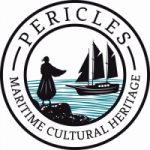
Are you familiar with the maritime and coastal heritage of the Aveiro region?
This animation looks into the coastal and maritime cultural heritage of the Aveiro region through a journey to the traditions and traditional activities that have shaped, and still do, the identity of the region.
It begins with a journey to the Northern Hemisphere seas where the fishermen of the Aveiro region used to go to fish codfish in small dory. Back on land, we pass the Aveiro Lighthouse and travel to the almost vanished ‘palheiros’ – wooden houses on the coast where the fishermen would rest and store their fishing gears. Here you can see the oxen brought from the farmlands to pull the ‘xávega’ nets, a traditional beach-seine fishery that is still practiced today, but with the help of tractors. Next to the Ria de Aveiro shore are the colourful ‘palheiros’ of Costa Nova, which once served as shelter for fishermen or as warehouses for salting or drying fish and today are major tourist attractions. During low tide, fishermen collect clams and cockles in the lagoon. At high tide they fish cuttlefish, lamprey, sole, shad, and eels, delights of the local gastronomy. We travel to the saltpans of Aveiro, where the ‘marnotos’ extract salt and fleur de sel and where the longlegs and other waders feed and nest. Food, agricultural products and construction materials were transported throughout the Ria in ‘mercantéis’ – traditional boats of the Ria de Aveiro. In turn, the ‘moliceiros’ (also traditional boats) were used to harvest ‘moliço’, the main agricultural fertilizer of that time, composed of algae and seagrasses. Nowadays, the ‘moliceiros’ are a symbol of the region and are used to transport tourists during guided tours in the lagoon and in the urban canals of the city of Aveiro.
This animation is also an invitation for you to share your memories and cultural heritage on the PERICLES geoportal: https://mapyourheritage.eu/. Register and upload your memories, stories, pictures, sound and videos. Find the instructions here.
The animation had the contribution of the Ethnomusicology Institute – Music and Dance Research Centre (INET-md) through the provision of sounds from the Aveiro Sounds and Memories Archive of the SOMA project.
Já conhece a herança marítima e costeira da região de Aveiro?
Esta animação aborda o património cultural costeiro e marítimo da região de Aveiro através de uma viagem às tradições e atividades tradicionais que marcaram, e ainda marcam, a identidade da região.
Começa com uma viagem aos mares do hemisfério norte onde os pescadores da região passavam temporadas na pesca do bacalhau em pequenos dóris. De regresso a terra, com o Farol de Aveiro a guiar os navegantes, viajamos até aos quase extintos palheiros do litoral, onde os pescadores descansavam e guardavam as suas artes. Aqui observam-se bois marinhões trazidos das terras agrícolas para puxar as redes da xávega, uma arte de pesca ancestral que ainda hoje é possível apreciar nesta costa, mas com auxílio de tratores. Junto à margem da Ria de Aveiro surgem os palheiros coloridos da Costa Nova, que outrora serviram de abrigo aos pescadores ou de armazéns de salga ou seca de peixe e hoje são verdadeiras atrações turísticas. Durante a maré baixa, os mariscadores apanham amêijoa e berbigão na Ria. Na maré alta pesca-se choco, lampreia, linguado, sável e enguias, iguarias da gastronomia local. Viajamos até ao salgado de Aveiro, onde o marnoto extrai, de forma artesanal, sal e flor de sal das marinhas e onde o perna-longa e outras aves limícolas se alimentam e nidificam. Os bens alimentares, produtos agrícolas e materiais de construção eram transportados por toda a Ria em mercantéis. Por sua vez, os moliceiros destinavam-se à apanha de moliço, o principal fertilizante agrícola da época, constituído por algas e plantas aquáticas superiores. Nos dias de hoje, os moliceiros são um símbolo da região e usados para transportar turistas durante as visitas guiadas na laguna e nos canais urbanos da cidade de Aveiro.
Esta animação é também um convite à partilha de memórias e da herança cultural no geoportal do PERICLES: https://mapyourheritage.eu/pt/. Para isso, basta registar-se e carregar as suas fotografias, histórias, sons, vídeos! Siga as instruções aqui.
A animação contou com o apoio do Instituto de Etnomusicologia – Centro de Estudos em Música e Dança (INET-md) através da cedência de sons do Arquivo de Sons e Memórias de Aveiro do projeto SOMA.
